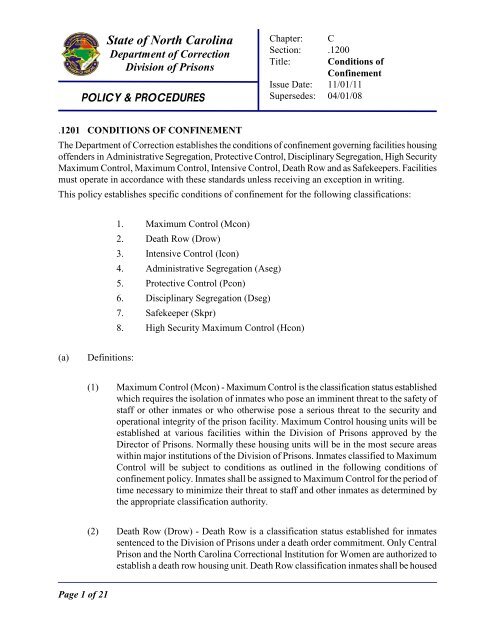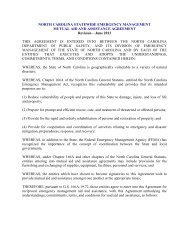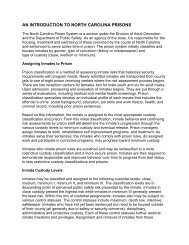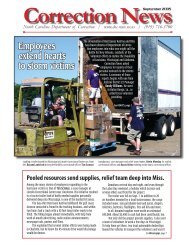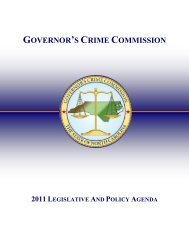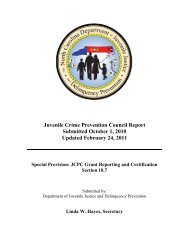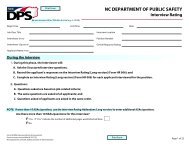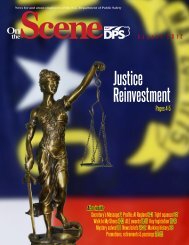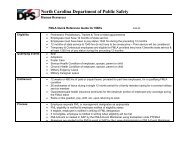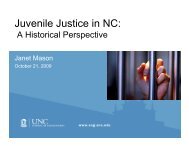State of North Carolina - North Carolina Department of Public Safety
State of North Carolina - North Carolina Department of Public Safety
State of North Carolina - North Carolina Department of Public Safety
You also want an ePaper? Increase the reach of your titles
YUMPU automatically turns print PDFs into web optimized ePapers that Google loves.
Page 1 <strong>of</strong> 21<br />
<strong>State</strong> <strong>of</strong> <strong>North</strong> <strong>Carolina</strong><br />
<strong>Department</strong> <strong>of</strong> Correction<br />
Division <strong>of</strong> Prisons<br />
POLICY & PROCEDURES<br />
Chapter: C<br />
Section: .1200<br />
Title: Conditions <strong>of</strong><br />
Confinement<br />
Issue Date: 11/01/11<br />
Supersedes: 04/01/08<br />
.1201 CONDITIONS OF CONFINEMENT<br />
The <strong>Department</strong> <strong>of</strong> Correction establishes the conditions <strong>of</strong> confinement governing facilities housing<br />
<strong>of</strong>fenders in Administrative Segregation, Protective Control, Disciplinary Segregation, High Security<br />
Maximum Control, Maximum Control, Intensive Control, Death Row and as Safekeepers. Facilities<br />
must operate in accordance with these standards unless receiving an exception in writing.<br />
This policy establishes specific conditions <strong>of</strong> confinement for the following classifications:<br />
(a) Definitions:<br />
1. Maximum Control (Mcon)<br />
2. Death Row (Drow)<br />
3. Intensive Control (Icon)<br />
4. Administrative Segregation (Aseg)<br />
5. Protective Control (Pcon)<br />
6. Disciplinary Segregation (Dseg)<br />
7. Safekeeper (Skpr)<br />
8. High Security Maximum Control (Hcon)<br />
(1) Maximum Control (Mcon) - Maximum Control is the classification status established<br />
which requires the isolation <strong>of</strong> inmates who pose an imminent threat to the safety <strong>of</strong><br />
staff or other inmates or who otherwise pose a serious threat to the security and<br />
operational integrity <strong>of</strong> the prison facility. Maximum Control housing units will be<br />
established at various facilities within the Division <strong>of</strong> Prisons approved by the<br />
Director <strong>of</strong> Prisons. Normally these housing units will be in the most secure areas<br />
within major institutions <strong>of</strong> the Division <strong>of</strong> Prisons. Inmates classified to Maximum<br />
Control will be subject to conditions as outlined in the following conditions <strong>of</strong><br />
confinement policy. Inmates shall be assigned to Maximum Control for the period <strong>of</strong><br />
time necessary to minimize their threat to staff and other inmates as determined by<br />
the appropriate classification authority.<br />
(2) Death Row (Drow) - Death Row is a classification status established for inmates<br />
sentenced to the Division <strong>of</strong> Prisons under a death order commitment. Only Central<br />
Prison and the <strong>North</strong> <strong>Carolina</strong> Correctional Institution for Women are authorized to<br />
establish a death row housing unit. Death Row classification inmates shall be housed
11/01/11<br />
Conditions <strong>of</strong> Confinement<br />
in a secure area <strong>of</strong> the facility and segregated from the general inmate population in<br />
so far as feasible.<br />
(3) Intensive Control (Icon) - Intensive Control is a classification status for inmates who<br />
have shown disruptive behavior through disciplinary <strong>of</strong>fenses, assaultive actions or<br />
confrontations, or who are so continuously a disruptive influence on the operation <strong>of</strong><br />
the facility that they require more structured management by prison authorities.<br />
Intensive Control status is generally less restrictive than the Maximum Control status.<br />
(4) Administrative Segregation (ASeg) - Administrative Segregation is the classification<br />
status for inmates who must be temporarily segregated from the general inmate<br />
population. This segregation status may be in a single cell or other housing unit<br />
determined appropriate by the facility head. Initial placement is primarily utilized for<br />
short-term removal from the regular population for administrative purposes based<br />
upon one or more <strong>of</strong> the following conditions:<br />
(A) to protect staff and other inmates from the threat <strong>of</strong> harm by the inmate;<br />
(B) to minimize the risk <strong>of</strong> escape by the inmate or others influenced by his/her<br />
actions;<br />
(C) to preserve order;<br />
(D) to provide necessary control while completing an investigation; or<br />
(E) to remove an inmate from the population as a cooling <strong>of</strong>f measure.<br />
(5) Protective Control (Pcon) - Protective Control is the classification status which<br />
inmates may be assigned separate from the general inmate population in order to<br />
protect the inmate from self-injury or the threat <strong>of</strong> harm by other inmates. Protective<br />
Control housing units will be established at various facilities within the Division <strong>of</strong><br />
Prisons approved by the Director <strong>of</strong> Prisons.<br />
(6) Disciplinary Segregation (DSeg) - Disciplinary Segregation is the classification status<br />
assigned to inmates who are subject to punishment pursuant to authorized Division<br />
disciplinary procedures following being found guilty <strong>of</strong> a rule violation. Disciplinary<br />
Segregation housing units will be established at various facilities within the Division<br />
<strong>of</strong> Prisons approved by the Director <strong>of</strong> Prisons to the extent necessary in order to<br />
enforce inmate conduct rules.<br />
Page 2 <strong>of</strong> 21 Chapter C .1200
11/01/11<br />
Conditions <strong>of</strong> Confinement<br />
(7) Safekeeper (Skpr) - Safekeeper is the classification status established for inmates<br />
transferred to the Division from local confinement facilities for the purpose <strong>of</strong> pretrial<br />
detention. Inmates classified as Safekeeper shall be housed in a cell separate<br />
from that used for the confinement <strong>of</strong> inmates convicted <strong>of</strong> criminal behavior except<br />
when admission to an inpatient prison medical or mental health unit is required to<br />
provide services deemed necessary by a prison health care clinician. Facilities within<br />
the Division <strong>of</strong> Prisons will be designated and approved by the Director <strong>of</strong> Prisons to<br />
house Safekeepers.<br />
(8) High Security Maximum Control (Hcon) - High Security Maximum Control is the<br />
classification status established for inmates who pose the most serious threat to the<br />
safety <strong>of</strong> staff and other inmates or who pose the most serious threat to the security<br />
and integrity <strong>of</strong> prison facilities and require more security than can be afforded in<br />
Maximum Control.<br />
(b) Authority to Designate Segregation and Control Housing<br />
(1) Maximum Control (Mcon): Director <strong>of</strong> Prisons<br />
(2) Death Row (Drow): Wardens - Central Prison/ NCCIW<br />
(3) Intensive Control (Icon): Director <strong>of</strong> Prisons<br />
(4) Administrative Segregation (Aseg): Superintendent/Warden<br />
(5) Protective Control (Pcon): Director <strong>of</strong> Prisons<br />
(6) Disciplinary Segregation (Dseg): Director <strong>of</strong> Prisons<br />
(7) Safekeeper (Skpr): Director <strong>of</strong> Prisons<br />
(8) High Security Maximum Control (Hcon): Director <strong>of</strong> Prisons<br />
(c) No inmate is entitled to specific conditions <strong>of</strong> confinement until he/she has been transferred<br />
to a facility designated for that specific type <strong>of</strong> control. As an example, an inmate approved<br />
for HCON should be housed under the conditions <strong>of</strong> confinement for MCON until<br />
Page 3 <strong>of</strong> 21 Chapter C .1200
11/01/11<br />
transferred to an HCON facility.<br />
Conditions <strong>of</strong> Confinement<br />
(d) Appropriate staff shall be responsible for making all entries into the Offender Population<br />
Unified System (OPUS).<br />
(e) All segregated and control inmates must be personally observed by custody staff at least<br />
every thirty (30) minutes on an irregular schedule. Inmates who are violent or mentally<br />
disordered or who demonstrate unusual or bizarre behavior receive more frequent<br />
observation consistent with the Division’s Health Care policy, TXIII-7 Self-Injurious<br />
Behavior. At Risk Self-Injurious Behavior inmates will be under continuing observation<br />
consistent with the Division’s Health Care policy, TXIII-7 Self Injurious Behavior. (4-4257)<br />
(f) All segregated and control inmates must receive daily visits from the <strong>of</strong>ficer in charge, daily<br />
visits from a qualified health care staff member (unless medical attention is needed more<br />
frequently), and visits from program staff upon request by staff or inmates. Facilities who<br />
don’t have access to 24/7 medical staff will utilize the Health Care Policy and Procedures for<br />
Triage (TX I-8) Appropriate staff shall be responsible for documenting these visits. (4-4258)<br />
(g) Inmates in Administrative Segregation, Maximum Control, Intensive Control, and Protective<br />
Custody will have their status reviewed and documented by designated staff every seven days<br />
for the first two (2) months and at least every thirty (30) days thereafter. This review<br />
schedule will be continuous for inmates who moved from Aseg to Control status, etc. (4-<br />
4253)<br />
(h) Significant events will be logged on the DC-141 by staff assigned to the control facility.<br />
Significant events may include medical attention, shower, exercise, meals, and any behavior<br />
warranting staff intervention. The DC-141 will be completed on each inmate. DC-141s are<br />
not required for Death Row and Safekeepers.<br />
(i) A control facility log indicating date and time entering and exiting the unit and the purpose <strong>of</strong><br />
the visit will be maintained and signed by all staff entering the control unit. (4-4260)<br />
(j) Any time a segregated or control inmate is denied <strong>of</strong> any usually authorized item or activity,<br />
a report <strong>of</strong> the action is filed in the inmate’s case record and forwarded to the facility’s<br />
Assistant Superintendent for Custody and Operations. (4-4265)<br />
Page 4 <strong>of</strong> 21 Chapter C .1200
11/01/11<br />
.1202 PROCEDURE<br />
Conditions <strong>of</strong> Confinement<br />
The application <strong>of</strong> each standard (condition <strong>of</strong> confinement) is specified in the bold-faced column<br />
boxes immediately following each standard.<br />
.1203 SANITATION/SAFETY/PERSONAL HYGIENE<br />
(a) Inmates will be required to maintain care <strong>of</strong> living quarters and observe standards <strong>of</strong> personal<br />
cleanliness as outlined in B .0301 (c) and (d) unless stated otherwise in this policy. Cleaning<br />
materials necessary for this purpose shall be furnished and controlled by supervisory staff.<br />
Housing facilities shall be adequately heated, properly lighted, and adequately ventilated and<br />
inspected daily or more <strong>of</strong>ten.<br />
Skpr Pcon Aseg Icon Mcon Hcon Dseg Drow<br />
(b) Personal safety standards shall be maintained in each cell.<br />
Skpr Pcon Aseg Icon Mcon Hcon Dseg Drow<br />
(c) To prevent the risk <strong>of</strong> fire and to minimize potential damage to state property, smoking<br />
materials will not be allowed in sections <strong>of</strong> the facility housing Administrative Segregation,<br />
Disciplinary Segregation, High Security Maximum Control, Maximum Control and Intensive<br />
Control. Where <strong>of</strong>fender classifications are mixed, restrictions on smoking materials will be<br />
imposed by the facility head.<br />
Aseg Icon Mcon Hcon Dseg<br />
(d) The facility head shall determine the level <strong>of</strong> restriction <strong>of</strong> smoking materials for Protective<br />
Control, death row, and safekeeper inmates.<br />
Skpr Pcon Drow<br />
(e) Cell inspections will be logged on a shift log.<br />
Skpr Pcon Aseg Icon Mcon Hcon Dseg Drow<br />
Page 5 <strong>of</strong> 21 Chapter C .1200
11/01/11<br />
Conditions <strong>of</strong> Confinement<br />
(f) Assigned inmates shall maintain standards <strong>of</strong> personal hygiene as per Division policy<br />
E.2100. All inmates without funds shall be issued necessary personal hygiene items. The<br />
issuance <strong>of</strong> personal hygiene items to inmates without funds is an internal matter governed<br />
by DOC Fiscal Administration Policies and Procedures, Section .1105.<br />
Skpr Pcon Aseg Icon Mcon Hcon Dseg Drow<br />
(g) Personal hygiene kits will be provided for all inmates assigned to Intensive Control,<br />
Maximum Control and High Security Maximum Control.<br />
Icon Mcon Hcon<br />
(h) Inmates assigned to control will be eligible for a haircut after serving thirty (30) days <strong>of</strong><br />
confinement. Thereafter, haircuts may be requested once every thirty (30) days. Haircuts<br />
should be pursuant to policy E.2107. Haircuts will be documented on the DC-141.<br />
Skpr Pcon Aseg Icon Mcon Hcon Dseg Drow<br />
.1204 MEALS<br />
(a) Inmates assigned to administrative and Disciplinary Segregation, Maximum Control,<br />
safekeeping, Intensive Control, and High Security Maximum Control shall receive meals<br />
in their cells.<br />
Skpr Aseg Icon Mcon Hcon Dseg<br />
(b) Inmates assigned to Protective Control and death row may be permitted to receive meals<br />
outside the cell if control can be maintained in the protective and death row facility.<br />
Pcon Drow<br />
(c) Safekeepers may receive their meals in the dining facility provided the route to and from<br />
the dining facility is completely cleared <strong>of</strong> all other inmates and provided further there are<br />
no other inmates, including food service workers, in the dining facility during the meals.<br />
Otherwise, Safekeepers should receive their meals in their cell.<br />
Page 6 <strong>of</strong> 21 Chapter C .1200
11/01/11<br />
Skpr<br />
.1205 SHOWER/SHAVE<br />
Conditions <strong>of</strong> Confinement<br />
(a) Unless specifically restricted under the provisions <strong>of</strong> this policy, inmates assigned<br />
Administrative and Disciplinary Segregation, Safekeeping, Maximum Control, Intensive<br />
Control, High Security Maximum Control and Death row will have the opportunity to<br />
shave and shower at least three times per week. Showers will be limited to a maximum <strong>of</strong><br />
ten (10) minutes per day. Medical authorities may grant exceptions to the three times per<br />
week shower/shave requirement for specific reasons. The action or the refusal to shave or<br />
shower shall be documented on the DC-141. (4-4262)<br />
Skpr Pcon Aseg Icon Mcon Hcon Dseg Drow<br />
(b) Exceptions to the requirement for shower/shave may be approved by the Regional<br />
Director or designated representative for a specified period <strong>of</strong> time upon consultation with<br />
the Director <strong>of</strong> Prisons. The request for exception outlining the reasons for the action<br />
shall be submitted through the chain <strong>of</strong> command as described in Section .1216. Causes<br />
for requesting exceptions may include but are not limited to, facility needs and<br />
contingencies created by prison emergencies, natural disasters, or loss or curtailment <strong>of</strong><br />
physical plant operations as the result <strong>of</strong> construction or renovation projects. In emergency<br />
situations, the requirement for shower and shave may be suspended by the Emergency<br />
Response Manager pending notification and/or instructions from the Region Director or<br />
designee.<br />
Skpr Pcon Aseg Icon Mcon Hcon Dseg Drow<br />
(c) An inmate may be denied shower and shave on a daily basis for refusing to comply with<br />
control procedures. Cell restriction may be considered if the inmate demonstrates<br />
behavior, which presents a clear and present danger to staff or other inmates, if the inmate<br />
is removed from the cell. The reasons for restricting the shower/exercise period shall be<br />
documented on a DC-141.<br />
Skpr Pcon Aseg Icon Mcon Hcon Dseg Drow<br />
(d) Maximum Control and High Security Maximum Control inmates will be showered<br />
individually. Refer to Section .1217 a. 2. for requirement for application <strong>of</strong> restraints<br />
Page 7 <strong>of</strong> 21 Chapter C .1200
11/01/11<br />
during movement to and from shower exercise areas.<br />
Mcon Hcon<br />
Conditions <strong>of</strong> Confinement<br />
(e) Inmates who present a threat to the order <strong>of</strong> security <strong>of</strong> the institution may be showered<br />
and shaved individually in full restraints if necessary.<br />
Skpr Pcon Aseg Icon Mcon Hcon Dseg Drow<br />
(f) Other than Maximum Control and High Security Maximum Control, assigned inmates<br />
may be showered and shaved in small, manageable groups as defined by the individual<br />
facility's standard operating procedures.<br />
Skpr Pcon Aseg Icon Dseg Drow<br />
.1206 EXERCISE PERIODS<br />
(a) Unless specifically restricted under the provisions <strong>of</strong> this policy, inmates assigned to death<br />
row and inmates assigned as Safekeepers shall be provided one hour per day to exercise<br />
outside the cell. This action or the refusal to exercise shall be documented on the DC-141.<br />
(4-4270)<br />
Skpr Drow<br />
(b) Inmates assigned to Administrative Segregation, and Disciplinary Segregation, Intensive<br />
Control, Maximum Control, High Security Maximum Control, Protective Control, shall<br />
be allowed one hour per day, five days per week exercise outside the cell, unless safety or<br />
security considerations dictate otherwise. Medical authorities may grant exceptions to the<br />
five times per week exercise requirement for specific reasons. The exercising <strong>of</strong> an inmate<br />
or the inmate’s refusal to exercise shall be documented on form DC-141.<br />
Pcon Aseg Icon Mcon Hcon Dseg<br />
(c) Outdoor exercise cells should be used as the primary exercise areas except during<br />
inclement weather or for security reasons. Inmates should be allowed to exercise<br />
unrestrained subject to any exception which may be granted by the Director's<br />
Page 8 <strong>of</strong> 21 Chapter C .1200
11/01/11<br />
Conditions <strong>of</strong> Confinement<br />
Classification Authority (DCA) for male inmates or by the Director’s Classification<br />
Committee (DCC) for female inmates under provisions .1217 <strong>of</strong> this policy. Exception:<br />
Inmates assigned to control status who are housed in facilities designated High Security<br />
Maximum Control by the Director <strong>of</strong> Prisons will exercise in exercise areas consistent<br />
with the Progressive Behavioral Program level to which the inmate is assigned.<br />
Skpr Pcon Aseg Icon Mcon Hcon Dseg Drow<br />
(d) Exceptions to the requirement for exercise periods may be approved by the Regional<br />
Director or designated representative for a specified period <strong>of</strong> time upon consultation with<br />
the Director <strong>of</strong> Prisons. The request for exception outlining the reasons for the action<br />
shall be submitted through the chain <strong>of</strong> command as described in Section .1216. Causes<br />
for requesting exceptions may include but are not limited to, facility needs and<br />
contingencies created by prison emergencies, natural disasters, or loss or curtailment <strong>of</strong><br />
physical plant operations as the result <strong>of</strong> construction or renovation projects. In emergency<br />
situations, the requirement for exercise periods may be suspended by the Emergency<br />
Response Manager pending notification and/or instructions from the Region Director or<br />
designee.<br />
Skpr Pcon Aseg Icon Mcon Hcon Dseg Drow<br />
(e) An inmate may be denied exercise on a daily basis for refusing to comply with control<br />
procedures. Cell restriction may be considered if the inmate demonstrates behavior, which<br />
presents a clear and present danger to staff or other inmates, if the inmate is removed from<br />
the cell. The reasons for restricting the shower/exercise period shall be documented on a<br />
DC-141.<br />
Skpr Pcon Aseg Icon Mcon Hcon Dseg Drow<br />
(f) Maximum Control and High Security Maximum Control inmates will be exercised<br />
individually. Refer to section. 1216 (a) (2), concerning requirements for application <strong>of</strong><br />
restraints during movement to and from exercise areas.<br />
Mcon Hcon<br />
(g) Inmates who present a threat to the order <strong>of</strong> security <strong>of</strong> the institution may be showered<br />
and exercised individually in full restraints if necessary.<br />
Page 9 <strong>of</strong> 21 Chapter C .1200
11/01/11<br />
Conditions <strong>of</strong> Confinement<br />
Skpr Pcon Aseg Icon Mcon Hcon Dseg Drow<br />
(h) Other than Maximum Control and High Security Maximum Control, assigned inmates<br />
may be showered and exercised in small, manageable groups as defined by the individual<br />
facility's standard operating procedures.<br />
Skpr Pcon Aseg Icon Dseg Drow<br />
.1207 PROCEDURES TO RESTRICT OUTSIDE CELL ACTIVITIES<br />
(a) In any instance where an inmate, if allowed outside the cell, has seriously assaulted or<br />
threatened to assault staff or other inmates or where significantly disruptive behavior has<br />
been demonstrated or threatened, such action shall be documented and additional<br />
structured limits on outside cell activities for that inmate shall be imposed. These limits<br />
may be initially authorized by the facility head or designee for not more than three (3)<br />
working days.<br />
Skpr Pcon Aseg Icon Mcon Hcon Dseg Drow<br />
Restrictions may include:<br />
(1) Movement to and from shower/exercise area in restraints.<br />
(2) Exercise in control restraints.<br />
(3) Shower in restraints.<br />
(4) Temporary suspension <strong>of</strong> visits<br />
(b) Procedures to restrict outside cell activities beyond three (3) working days are:<br />
(1) A control referral shall be prepared documenting the reasons for the restrictions. It<br />
shall be forwarded through the chain <strong>of</strong> command to the Manager <strong>of</strong><br />
Classification. The Classification Manager will review the recommendations and<br />
forward the referral to the Director’s Classification Authority (DCA) if the inmate<br />
is male and to the Director’s Classification Committee (DCC) if the inmate is<br />
female.<br />
Page 10 <strong>of</strong> 21 Chapter C .1200
11/01/11<br />
Conditions <strong>of</strong> Confinement<br />
Skpr Pcon Aseg Icon Mcon Hcon Dseg Drow<br />
(2) Upon notification by the Classification Manager, the Director’s Classification<br />
Authority/Director’s Classification Committee shall within five (5) working days<br />
set the date on which a hearing for the inmate will be held. Outside cell activities<br />
shall be restricted pending the hearing. Working days are Monday through Friday<br />
exclusive <strong>of</strong> holidays.<br />
Skpr Pcon Aseg Icon Mcon Hcon Dseg Drow<br />
(3) The inmate shall be provided forty-eight (48) hours advanced written notice (DC-<br />
123) <strong>of</strong> the hearing to consider additional restrictions. (4-4302)<br />
Skpr Pcon Aseg Icon Mcon Hcon Dseg Drow<br />
(4) If additional restrictions are approved by the Director's Classification<br />
Authority/Director’s Classification Committee, this is documented on the IS11.<br />
Skpr Pcon Aseg Icon Mcon Hcon Dseg Drow<br />
(5) In any case where the Director's Classification Authority/Director’s Classification<br />
Committee has approved the imposition <strong>of</strong> additional restrictions on outside cell<br />
exercise activities, each inmate shall be advised <strong>of</strong> specific alternative exercise<br />
programs.<br />
Skpr Pcon Aseg Icon Mcon Hcon Dseg Drow<br />
(6) Shower and exercise restrictions imposed by the Director’s Classification<br />
Authority/Director’s Classification Committee shall be reviewed at 30-day<br />
intervals by the Director’s Classification Authority/Director’s Classification<br />
Committee (DC-121). Authority to remove the restrictions shall be vested with<br />
the Facility Head or designee.<br />
Skpr Pcon Aseg Icon Mcon Hcon Dseg Drow<br />
Page 11 <strong>of</strong> 21 Chapter C .1200
11/01/11<br />
.1208 TRUST FUND WITHDRAWALS<br />
Conditions <strong>of</strong> Confinement<br />
(a) Assigned inmates may draw or otherwise be allowed access to the amount <strong>of</strong> personal<br />
funds authorized by policy Section F.0503 (2) per week from the Inmate Trust Fund<br />
unless assigned to Disciplinary Segregation, Intensive Control, Maximum Control or High<br />
Security Maximum Control.<br />
Skpr Pcon Aseg Drow<br />
(b) Disciplinary Segregation inmates will be allowed ten dollars ($10.00) per week.<br />
Dseg<br />
(c) Inmates assigned to Intensive Control, Maximum Control and High Security Maximum<br />
Control may not make trust fund withdrawals with the following exceptions: They may,<br />
be allowed to send money to family members, as usual, and to make weekly purchases<br />
from the canteens as outlined in Section C.1209 ( c) <strong>of</strong> this policy. They may also order<br />
authorized publications directly from the publisher.<br />
.1209 CANTEEN ORDERS<br />
Icon Mcon Hcon<br />
(a) Inmates assigned as Safekeepers, to Protective Control, Administrative Segregation and<br />
death row are permitted to have canteen orders filled not less three (3) times per week.<br />
Skpr Pcon Aseg Drow<br />
(b) Inmates assigned to Disciplinary Segregation will not be permitted to have canteen orders<br />
filled except for stamps, over the counter medications, and essential personal hygiene<br />
items.<br />
Dseg<br />
Page 12 <strong>of</strong> 21 Chapter C .1200
11/01/11<br />
Conditions <strong>of</strong> Confinement<br />
(c) Inmates assigned to Intensive Control, Maximum Control and High Security Maximum<br />
Control shall be afforded no canteen privileges with the following exceptions: They may<br />
purchase a radio, a watch, and shower shoes on an as needed basis. They may purchase<br />
postage stamps, limited over the counter medication and three radio batteries per week.<br />
Prior to purchasing new batteries, the old batteries must be turned in. Control Population<br />
Hygiene Kits will be supplied by the facility. The number <strong>of</strong> stamps an inmate will be<br />
allowed to possess is limited to twenty five. Inmates found to be in possession <strong>of</strong> more<br />
than twenty five stamps will be subject to disciplinary action. Excess stamps will be<br />
confiscated and held in a secure manner pending disciplinary proceedings. Facilities with<br />
a cash drop box will drop the excess stamps in the box in the same manner they drop cash.<br />
Facilities should modify their facility form to add a category for stamps. In both instances,<br />
the excess stamps will go into a facility safe as soon as possible. Once the inmate pleads<br />
guilty or is found guilty <strong>of</strong> the disciplinary <strong>of</strong>fense, the stamps will be transferred into the<br />
indigent stamp inventory. Those stamps will be utilized to mail letters for indigent<br />
inmates. Each facility will be responsible for making provisions to allow inmates to mail<br />
his/her legal mail, if the inmate can demonstrate that additional stamps are required. This<br />
process will not hinder the inmate’s right to mail legal documents. A comb or brush and a<br />
pen will be issued, as well, by the facility.<br />
Icon Mcon Hcon<br />
(d) Inmates assigned to Intensive Control, Maximum Control and High Security Maximum<br />
Control do not have canteen privileges, therefore they must request medication through<br />
sick call, as opposed to purchasing medication from the canteen. The only exception for<br />
this as noted in item (c) above is that they may purchase limited over the counter<br />
medication such as Tylenol and antacid.<br />
.1210 PERSONAL PROPERTY<br />
Icon Mcon Hcon<br />
(a) Assigned inmates may have personal property including authorized religious material,<br />
books and magazines not exceeding two (2) cubic feet. Refer to the Religious Practices<br />
Reference Manual for a list <strong>of</strong> authorized items <strong>of</strong> personal property for inmates on<br />
control status. Under no circumstances will inmates be allowed to accumulate materials<br />
constituting a health, fire, or security hazard. Unauthorized property will be handled in<br />
accordance with DOP policy F.0504. Inmates will be allowed to possess legal materials<br />
in accordance with Division <strong>of</strong> Prisons’ Policies F .0503 (b) and G .0208.<br />
Page 13 <strong>of</strong> 21 Chapter C .1200
11/01/11<br />
Conditions <strong>of</strong> Confinement<br />
Skpr Pcon Aseg Icon Mcon Hcon Dseg Drow<br />
(b) Personal and state issued property may be temporarily removed from the cell if the inmate<br />
presents or threatens behavior that could result in loss <strong>of</strong> property or life. Such behavior<br />
may include self-injurious actions or setting fires. Removal and restoration <strong>of</strong> property<br />
shall be documented on a DC-141 and DC-160.<br />
Skpr Pcon Aseg Icon Mcon Hcon Dseg Drow<br />
.1211 TELEVISION PRIVILEGES<br />
(a) Inmates assigned to Protective Control will be permitted television privileges daily<br />
(Monday through Friday) from 5:00 p.m. to 10:00 p.m. Saturday, Sunday, and holiday<br />
television privileges will be from 1:00 p.m. through 10:00 p.m. The <strong>of</strong>ficer in charge <strong>of</strong><br />
the facility may extend television hours for selected events.<br />
Pcon<br />
(b) Inmates assigned to Administrative Segregation, Intensive Control, Maximum Control,<br />
High Security Maximum Control and Disciplinary Segregation will not be authorized<br />
television privileges.<br />
Aseg Icon Mcon Hcon Dseg<br />
(c) If approved by the Director <strong>of</strong> Prisons, television privileges may be authorized by the<br />
facility head for death row and safekeeper inmates depending upon programmatic needs<br />
<strong>of</strong> the <strong>of</strong>fender and physical plant characteristics.<br />
Skpr Drow<br />
(d) Television privileges may be suspended without prior notice by the <strong>of</strong>ficer in charge <strong>of</strong><br />
the facility, if necessary, to maintain order and control. If such action is taken, the <strong>of</strong>ficer<br />
in charge will document the reasons for this action on the segregation log.<br />
Skpr Pcon Drow<br />
Page 14 <strong>of</strong> 21 Chapter C .1200
11/01/11<br />
.1212 RADIOS<br />
Conditions <strong>of</strong> Confinement<br />
(a) Assigned inmates will be permitted to use DOP authorized radios with an<br />
earplug/earphone only in accordance with policy F .0503 (6). No inmate shall be allowed<br />
to have in his/her possession more batteries than required to operate his/her radio.<br />
Skpr Pcon Aseg Icon Mcon Hcon Drow<br />
(b) Radios may be confiscated without prior notice by the <strong>of</strong>ficer in charge <strong>of</strong> the facility, if<br />
necessary, to maintain order and control. When such action is taken, it will be<br />
documented on the DC-141 by the <strong>of</strong>ficer in charge <strong>of</strong> the facility and recorded on the<br />
inmate’s personal property inventory (DC-160).<br />
Skpr Pcon Aseg Icon Mcon Hcon Drow<br />
(c) Inmates assigned to Disciplinary Segregation will not be permitted to use a radio while in<br />
that status.<br />
.1213 MAIL<br />
Dseg<br />
(a) Inmates assigned shall have the same mail privileges as inmates in the population.<br />
Skpr Pcon Aseg Icon Mcon Hcon Dseg Drow<br />
(b) Incoming and outgoing mail will be handled in accordance with D .0307.<br />
Skpr Pcon Aseg Icon Mcon Hcon Dseg Drow<br />
.1214 TELEPHONE PRIVILEGES<br />
(a) Inmates assigned to safekeeping, Administrative Segregation, Intensive Control,<br />
Maximum Control, Protective Control and death row will be allowed telephone privileges<br />
Page 15 <strong>of</strong> 21 Chapter C .1200
11/01/11<br />
Conditions <strong>of</strong> Confinement<br />
based on control and safety considerations as designated by the Facility Head.<br />
Skpr Pcon Aseg Icon Mcon Drow<br />
(b) Inmates assigned to Disciplinary Segregation and High Security Maximum Control will<br />
be allowed limited telephone privileges except for calls related specifically to access to<br />
the attorney <strong>of</strong> record, based on control and safety considerations as designated by the<br />
Facility Head<br />
.1215 VISITS<br />
Hcon Dseg<br />
(a) Protective Control inmates will generally be allowed contact visiting privileges in<br />
prescribed visiting areas where possible.<br />
Pcon<br />
(b) Administrative or Disciplinary Segregation, Maximum Control, Intensive Control, High<br />
Security Maximum Control, Safekeepers and death row <strong>of</strong>fenders will normally visit only<br />
in the noncontact visiting area.<br />
Skpr Aseg Icon Mcon Hcon Dseg Drow<br />
(c) Visiting schedules shall be structured by appointment only between the hours <strong>of</strong> 9:00 a.m.<br />
and 3:00 p.m. Monday through Friday. No visiting privileges shall be allowed on state<br />
legal holidays. Visits will be limited to one (1) hour per visit. The <strong>of</strong>ficer in charge <strong>of</strong> the<br />
facility may alter the visiting day, time and the number <strong>of</strong> visits, or may suspend the visit.<br />
Skpr Pcon Aseg Icon Mcon Hcon Dseg Drow<br />
(d) Inmates assigned to Intensive Control, Maximum Control and High Security Maximum<br />
Control shall have visitation restricted to two times every thirty (30) days. The thirty (30)<br />
days will begin at the initiation <strong>of</strong> the first visit.<br />
Icon Mcon Hcon<br />
Page 16 <strong>of</strong> 21 Chapter C .1200
11/01/11<br />
.1216 USE OF RESTRAINTS-INTERNAL MOVEMENT/CONTROL<br />
Conditions <strong>of</strong> Confinement<br />
(a) The use <strong>of</strong> restraints shall be required to assure the safety <strong>of</strong> staff and inmates for any<br />
internal movement as follows:<br />
(1) Hand restraints may be authorized for Protective Control, death row, and<br />
Safekeepers.<br />
Skpr Pcon Drow<br />
(2) Hand restraints and waist controls are required for Maximum Control, Intensive<br />
Control and High Security Maximum Control inmates being moved from housing<br />
units to another location within the facility. Security procedures will be developed<br />
by the Facility Head <strong>of</strong> each facility housing Maximum Control, High Security<br />
Maximum Control, Intensive Control inmates to ensure that these inmates are<br />
moved in a safe and secure manner when movements <strong>of</strong> these inmates is required<br />
within the designated housing unit. Secure outside exercise areas located adjacent<br />
to the designated housing unit are considered part <strong>of</strong> the designated housing unit.<br />
Security procedures developed by the Facility Head <strong>of</strong> each facility must be<br />
approved by the Region Director.<br />
Icon Mcon Hcon<br />
(3) Leg restraints are authorized for any <strong>of</strong>fender presenting an immediate threat.<br />
Skpr Pcon Aseg Icon Mcon Hcon Dseg Drow<br />
(b) Except as provided in C.1217 (a) (3) above, inmates assigned to Protective Control,<br />
safekeeping and death row shall be showered and exercised without restraints in<br />
controllable groups or individually under appropriate staff supervision. If an inmate's<br />
current prior behavior warrants the use <strong>of</strong> restraints, this action shall be documented on<br />
the DC-141.<br />
Skpr Pcon Drow<br />
(c) The Officer-In-Charge may authorize the use <strong>of</strong> restraints to immobilize an inmate in<br />
accordance with F .1504 (e).<br />
Page 17 <strong>of</strong> 21 Chapter C .1200
11/01/11<br />
Conditions <strong>of</strong> Confinement<br />
Skpr Pcon Aseg Icon Mcon Hcon Dseg Drow<br />
(d) Leg cuffs will be used on all High Security Maximum Control inmates.<br />
.1217 ACCESS TO HEALTH CARE<br />
Hcon<br />
(a) Inmates shall have access to health care consistent with Health Care Policy.<br />
Skpr Pcon Aseg Icon Mcon Hcon Dseg Drow<br />
(b) Inmates requesting to be seen by the health care provider during regularly scheduled sick<br />
call shall make this request known to the <strong>of</strong>ficer in charge. Each inmate requesting to be<br />
seen shall be evaluated by the health care provider conducting scheduled sick call.<br />
Skpr Pcon Aseg Icon Mcon Hcon Dseg Drow<br />
(c) When it is not possible or appropriate, due to safety concerns for an inmate to be brought<br />
to medical for a sick call, a registered nurse or provider shall visit the inmate in the<br />
segregation area to evaluate, treat, or refer as deemed appropriate. A record <strong>of</strong> the visit<br />
shall be recorded on the control log. The results <strong>of</strong> sick call visits shall be recorded in the<br />
individual outpatient health record. If the inmate refuses medical care, this shall be<br />
documented on the DC-141.<br />
Skpr Pcon Aseg Icon Mcon Hcon Dseg Drow<br />
.1218 WORK ASSIGNMENTS<br />
(a) Wherever appropriate and consistent with custody and control considerations, inmates<br />
assigned may be required to perform structured task assignments.<br />
Skpr Pcon Aseg Icon Mcon Dseg Drow<br />
Page 18 <strong>of</strong> 21 Chapter C .1200
11/01/11<br />
(b) Safekeepers cannot be required to perform regular work assignments.<br />
Skpr<br />
.1219 PROGRAM ASSIGNMENTS<br />
Conditions <strong>of</strong> Confinement<br />
Inmates assigned to these controls may be authorized to participate in part time or in-cell<br />
programs provided adequate security is available; however, Safekeepers will not participate in<br />
program activities with convicted <strong>of</strong>fenders. These programs are:<br />
(a) Cell study<br />
Skpr Pcon Aseg Icon Mcon Hcon Dseg Drow<br />
(b) Portable Library<br />
Skpr Pcon Aseg Icon Mcon Hcon Dseg Drow<br />
(c) Pastoral Counseling<br />
Skpr Pcon Aseg Icon Mcon Hcon Dseg Drow<br />
(d) Religious Services<br />
(e) Anger Management<br />
Pcon Drow<br />
Pcon Icon Mcon Hcon Drow<br />
(f) Organized Recreational Activities<br />
Pcon Icon Drow<br />
Page 19 <strong>of</strong> 21 Chapter C .1200
11/01/11<br />
Additional programs require the approval <strong>of</strong> the Director <strong>of</strong> Prisons.<br />
.1220 SENTENCE CREDITS PROHIBITED<br />
Conditions <strong>of</strong> Confinement<br />
(a) Inmates assigned to Aseg, Icon, Dseg, Mcon and Hcon will not be eligible to receive<br />
sentence credits for task assignments or program assignments.<br />
Aseg Icon Mcon Hcon Dseg<br />
(b) Pretrial Safekeepers are not eligible for good time or earned time credits.<br />
Skpr<br />
.1221 LIBRARY<br />
Library books will be made available on a regular basis.<br />
Skpr Pcon Aseg Icon Mcon Hcon Dseg Drow<br />
.1222 TENNIS SHOES<br />
Inmates assigned to Intensive Control, Maximum Control and High Security Maximum Control<br />
Status will be provided with state issued tennis shoes.<br />
Icon Mcon Hcon<br />
.1223 TYLENOL AND ANTACID<br />
Inmates will be provided two Tylenol tablets and two antacid tablets per day upon request. There<br />
will be no charge to the inmate for the medication. The <strong>of</strong>ficer in charge <strong>of</strong> the housing area will<br />
maintain a log that must be completed prior to dispensing these medications. The log will list the<br />
following information: inmate name and number, housing location, date, time, inmate signature<br />
and <strong>of</strong>ficer’s initials. The log includes a disclaimer statement which the inmate must sign in order<br />
to receive the medication. This log will be submitted daily to the Nurse Supervisor/Lead Nurse. A<br />
medical staff person will review the logs daily to insure the medication is not being misused or<br />
that an individual inmate is not receiving daily dosages for problems that medical staff are not<br />
Page 20 <strong>of</strong> 21 Chapter C .1200
11/01/11<br />
aware <strong>of</strong>.<br />
Conditions <strong>of</strong> Confinement<br />
Skpr Pcon Aseg Icon Mcon Hcon Dseg Drow<br />
C1200_11_01_11.doc<br />
Page 21 <strong>of</strong> 21 Chapter C .1200


